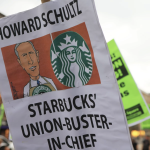Employers Spend More Than $400 Million on Union Busting

High-profile union organizing campaigns and attacks on those campaigns at companies such as Amazon, Starbucks, and Google have shined a spotlight on workers seeking better pay and working conditions. However, attempts to derail those efforts by corporations are on the rise, costing more than $400 million a year.
But that number is only the tip of the union-busting iceberg.
Here’s what we know about ‘union avoidance’ today:
- When workers seek to form unions, employers often hire “union-avoidance” consultants to dissuade and weaken workers’ unionization efforts. These consultants work to prevent a union election from taking place—and if that fails, to ensure that workers vote against the union.
- Employers spend a lot of money trying to derail union organizing campaigns. EPI estimates employers spend $433 million per year on union-avoidance consultants. This work is well compensated—consultants report being paid $350-plus hourly rates or $2,500-plus daily rates for their work to defeat union organizing efforts. This estimate is just a drop in the bucket because there is not enough data to reveal the true scope of what employers spend.1
- Employers are required to report certain union-avoidance expenditures. However, statutory exemptions and enforcement limitations severely limit the scope of reportable employer union-avoidance activities. As a result, relatively little data exist on employer expenditures on union avoidance.
- This reality makes it harder for workers to fight for their collective bargaining rights because they do not know the extent of their companies’ investments in union-busting, a figure that could empower them at the negotiating table when employers claim they can’t afford to increase pay and benefits.
- While the law requires employers and consultants to disclose their union-avoidance agreements, it provides an important exception when the consultant is merely providing the employer with “advice”—a term that is not defined in the statute and is exploited by many union-busting consulting firms.
- The Obama administration tried to rectify the problem by attempting to close this loophole through a regulatory action known as the “persuader” rule. In its proposal, the administration emphasized the significance of this loophole, stating: “Although 71 to 87 percent of employers hire consultants to manage counter-organizing campaigns, the Department has received very few reports on these activities because employers deemed them to fall under the ‘advice’ exemption.”2
- Unfortunately, business groups sued to prevent the rule from being enforced, and the Trump administration rescinded the rule. Without reform to the reporting system, we have little to no idea how much companies spend on union busting.
Table 1 lists just a few of the employers who filed mandatory reports with the Department of Labor during 2021.
Employers spend millions on union-avoidance consultantsAmounts union-avoidance consultants reported receiving from selected employers for work performed in 2021
| Employer | Amount reported |
|---|---|
| Amazon | $4,260,000 |
| United Natural Foods | $2,650,000 |
| American Auto Assoc., N. California, Nevada, Utah | $1,923,000 |
| Grocery Delivery E-Services (Hello Fresh) | $1,638,000 |
| Maine Health | $958,000 |
| El Milagro Tortillas | $863,000 |
| Curation Foods | $689,000 |
| Intralot | $251,000 |
| Garden Fresh Gourmet | $211,000 |
Source: Bob Funk and LaborLab's analysis of LM-10 forms filed by consultants with the U.S. Department of Labor (DOL) Office of Labor-Management Standards (OLMS), 2021, rounded to the nearest thousand dollars.
Policy recommendations
To expose the extent of corporations’ union-avoidance activities, policymakers should:
- Pass the Protecting the Right to Organize (PRO) Act, which would require disclosure of indirect persuader activities by union-avoidance consultants;
- Pass the No Tax Breaks for Union Busting Act, which would prevent employers from deducting union-avoidance expenditures from their taxes;
- Finalize Form LM-10 rulemaking requiring employers to attest if they are federal (sub)contractors, which would help fill an information gap on whether federal contractors are participating in union-avoidance activities; and
- Rescind the 2016 Special Enforcement Policy for Form LM-21, which states that the Office of Labor-Management Standards (OLMS) will not enforce the completion of Parts B and C of Form LM-21. Rescinding the policy would require union-avoidance consultants to itemize payments from employers they engage with each fiscal year.
Our blog post on the issue highlights recent case studies of union busting.
Notes
1. See Celine McNicholas, Margaret Poydock, Julia Wolfe, Ben Zipperer, Gordon Lafer, and Lola Loustaunau, Unlawful: U.S. Employers Are Charged with Violating Federal Law in 41.5% of All Union Election Campaigns, Economic Policy Institute, December 2019: To arrive at the $433 million figure, we take the $338 million dollar estimate from McNicholas et al. 2019, which covered the four-year period 2014–2017, and adjust it for inflation to 2023 dollars according to Consumer Price Index (CPI-U) estimates using the annual average of the BLS CPI-U for 2014–2017 and the Congressional Budget Office (February 2023) projection for the full-year 2023 CPI-U. The estimated rates for consultants are from McNicholas et al. 2019.
2. U.S. Department of Labor, “Overview/Summary: Persuader Agreements: Ensuring Transparency in Reporting For Employer and Labor Relations” (fact sheet), October 2016.
